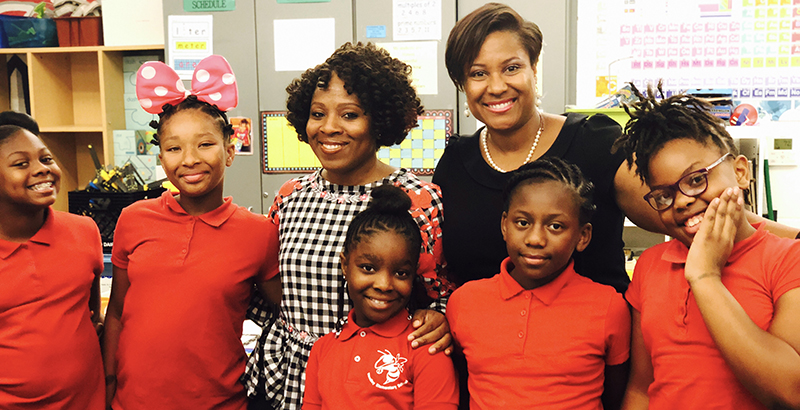A Principal’s View: How Introducing STEM Has Radically Changed My Washington, D.C., School — and Just Won Us a Major Innovation Award

Some might not expect a school in southeast Washington, D.C., to have the only all-black robotics team at a national competition. Others might look at Hendley Elementary School’s Partnership for Assessment of Readiness for College and Careers (PARCC) scores and not assume that our students are coding, problem-solving, and engaging in critical thinking daily. Even I could have been discouraged when I saw that less than 10 percent of our fourth- and fifth-grade students participated in the annual school science fair when I started as principal.
Instead, I was motivated by it.
Over the past year, we have made radical changes at Hendley and introduced our predominantly African-American pre-K3 through fifth-grade students to the world of science, technology, engineering, and math. I’m proud that our fifth-grade math proficiency rates on PARCC increased by 12 percentage points last year, but I’m even prouder that a student who struggled with behavioral challenges discovered his interest in physics at Hendley; that young scholars in our early childhood education classrooms learn to code by operating a train through Lego Education; and that our all-girls robotics team, the Sparkle Bots, prove that girls of color have a place in STEM.
And our work is being recognized. On Thursday night, our school won the Standing Ovation for D.C. Public Schools 2019 Innovation for Excellence Award and $25,000.
These changes didn’t come about with a sweeping reform. They are a result of D.C. Public Schools empowering school leaders to figure out what our students and communities need, and providing the resources and support we need to transform our schools.
Just a little over a year ago, I applied to a district initiative hoping for some extra funding and a few new books to add to my professional library. DCPS had just launched the Design Lab, a hub of innovation, and advertised it as a place to dream big and to think radically about a pathway toward enacting creative change within your school. The program began as an opportunity to think differently about our work and a safe space to pilot work within our own schools; it grew into 11 school teams transforming teaching and learning in our buildings in 11 different ways.
I was a little skeptical of the Design Lab because, as an eight-year veteran, I know the principalship is always filled with promises of autonomy, new programs, and fly-by-night approaches to school improvement that often fade to black right before another idea or initiative is introduced. But here’s what makes the Design Lab different:
● The focus is solely on school-level support. Reform starts with school-based teams, and the supports and resources come from district administrators.
● Innovation is the norm. From school visits, team-building activities, research-based design thinking tools, and relevant conferences, we are challenged to think boldly about our work and to grow our own practice and learning.
● There is no one-size-fits-all approach. The unique needs of each school community are always considered, and the Design Lab acts as a resource-rich think tank for school leaders to brainstorm, collaborate, and plan with like-minded thought partners in the work.
After seeing low turnout at our science fair, I worked with my teachers to have every fifth-grader complete a science fair project working with a mentor teacher. During the next school year, we included pairs of fourth-graders who completed individual projects. We used these changes in our science fair to promote equity, access, and opportunity for students.
The next question was — how do we build this to scale for all students?
We could not answer this question on our own, but with the support of the Design Lab, our school team — which included my math instructional coach, a special education teacher, a STEM teacher, a second-grade teacher, and a music teacher — developed innovative solutions to bring STEM to all students. Our DCPS Adopt-A-School Partner, the Monumental Sports & Entertainment Foundation, gifted us a STEM lab. Our STEM lab teacher, Ms. Hutchins, launched new classes and a robotics team for our fourth- and fifth-graders.
Today, we have harnessed the momentum of our success with STEM for all students. I am proud to say my school community is engaged in a STEM program for pre-K through fifth grade that brings engineering design challenges to students across all grade levels. Students explore, create, design, test, and try again. In our kindergarten classes, you might see students explaining how they designed packaging using a finite amount of paper, tape, and cotton balls to “ship a chip” – a single Pringle chip that could not be broken in transit. In our STEM lab, you could listen in on fourth-graders discussing whether they would build a simple or a complex machine to rescue a tiger from a moat, using a 3-D model of a prototype on an iPad.
Based on a school survey, 97 percent of teachers report higher levels of engagement during the design challenges process.
Hendley Elementary School is on the road to improvement and reform through ground-up pedagogical change, starting with our youngest learners. The work is messy and unpredictable, but our high levels of student engagement and rising rates of academic achievement are a testament to what can be accomplished when school-level reform is truly a partnership with district administration.
Sundai Riggins, EdD, spent eight years as a classroom teacher and two years as an assistant principal and is currently in her eighth year as a Washington, D.C., elementary school principal. Her school just won the Standing Ovation for D.C. Public Schools 2019 Innovation for Excellence Award.
Get stories like these delivered straight to your inbox. Sign up for The 74 Newsletter

;)